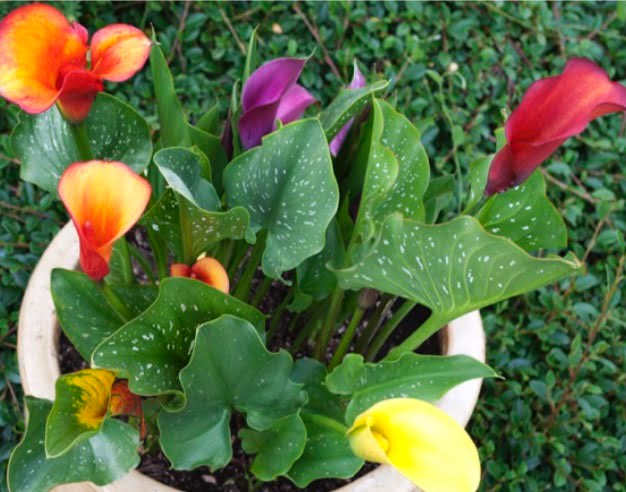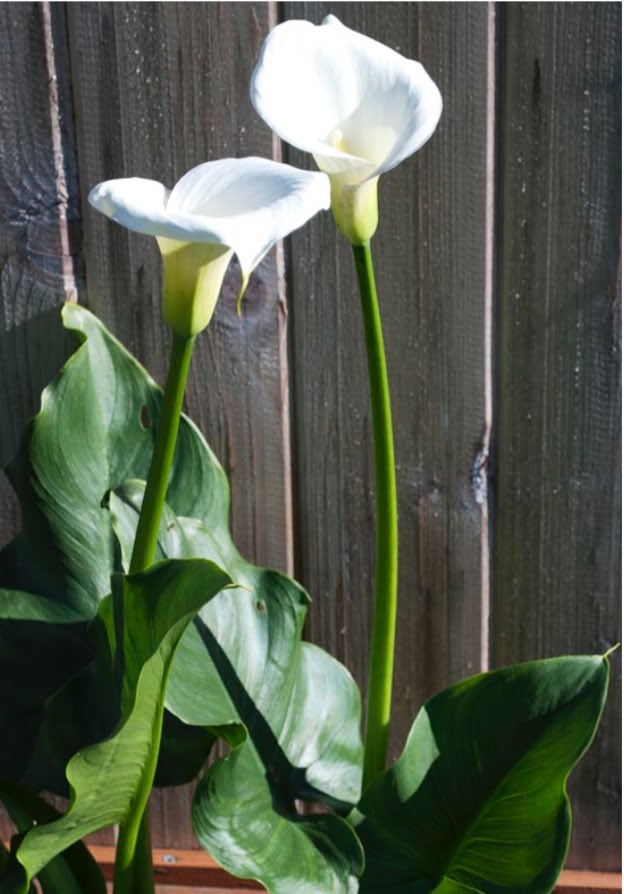[Ebook Việt Hoá] What's wrong with my houseplant (Có vấn đề gì với cây trong nhà của tôi?) - David Deardorff & Kathryn Wadsworth, Chi Zantedeschia - Chi Vân Môn
[Ebook Việt Hoá] What’s wrong with my houseplant?: Calla lily (Zantedeschia spp.)
- Biên tập: Dũng Cá Xinh
- Người dịch: Mai Nhung
ENGLISH
As with all aroids, the colorful part of the calla lily (Zantedeschia spp.) is the scoop-shaped spathe surrounding a finger-like spadix covered with minute flowers. Hundreds of these barely visible flowers are packed onto the spa- dix. The big, bright spathe and the gorgeous foliage are the reasons we love these plants. Georgia O’Keeffe loved them too. She featured the elegant and sophisticated white calla lily (Zantedeschia aethiopica) in many of her sensuous paintings. This is a big plant, to 3 feet tall and wide when grown indoors. Modern hybrids developed from Z. rehmannii and Z. elliottianaare smaller plants, to 12 inches high and wide as houseplants. Their very colorful spathes can be deep purple, lavender, cream, orange, light and deep pink, or bright yellow.


All calla lilies have a bulb-like underground rhizome that is perennial. Leaves and flowers sprout directly from the eyes in the tops of these rhizomes so there is no aboveground stem. White calla lily is nearly evergreen and does not go dormant. All the small colorful species and hybrids have a growth habit much like any temporary houseplant with bulbs: they go completely dormant in the autumn. Leaves of white calla lily are arrow-shaped, 18 inches long and 10 inches wide. They are usually not spotted, but some cultivars have silvery white spots on the leaves. Leaves of the smaller hybrids are also arrow-shaped, 10 to 12 inches long and 2.5 to 6 inches wide. Many have white spots on the leaves.
In late summer the small callas prepare for dormancy by ceasing to grow and flower. The leaves slowly turn yellow and fade away as the plant prepares to go to sleep and pulls all its resources down into the underground rhizome. Remove old flowers and fading leaves. Stop fertilizing the plant and reduce watering until it is completely dormant. When dormancy is complete, stop watering entirely. Place the plant in cool shade until you re-pot it in mid-winter. After re-potting, move the plant to warmth and light in early spring and begin to water again to encourage it to break dormancy and begin active growth.
Many people find that calla lilies in their second or subsequent years as houseplants are
not as vigorous and floriferous as they were in their first year, so they regard them as temporary houseplants and discard them when they go dormant.
This plant is toxic to people and pets and should be kept in an out-of-the-way place. Its tissues contain calcium oxalate crystals, and if leaves are chewed the crystals penetrate the soft tissues of lips, tongue, and throat, causing painful swelling, drooling, and vomiting. If you suspect a person or pet has ingested parts of this plant, or if a person or pet exhibits serious symptoms such as difficulty breathing, call your local emergency hotline, poison control center, or vet.
OPTIMUM HOUSEHOLD ENVIRONMENT
Read the Introduction for the specifics of each recommendation.
MEDIUM LIGHT.
These plants dislike direct sun- light and will be at their best in filtered or dap- pled light.
LOW TEMPERATURE.
Daytime 65 to 75°F, night- time 55 to 65°F.
AMPLE WATER.
Callas like lots of water when they are in active growth and flowering. Water whenever the top of the potting medium becomes dry to a depth of 0.5 inch. Stop watering during their dormant period.
HUMIDITY.
Calla lilies like high humidity. Mist your plant every other day with a spray bottle of water on a mist setting, or use a handheld mis- ter. Put the pot in a saucer or tray of water, making sure the bottom of the pot never sits directly in the water by raising the pot up on pot feet or pebbles.
POTTING MEDIUM.
Use any good organic, well- drained, general-purpose potting soil that incorporates organic fertilizer, mycorrhizal fungi, and other beneficial microbes.
FERTILIZER.
Use any balanced organic fertilizer. Apply once a month through the growing sea- son. Do not fertilize during the dormant period.
POTTING.
In mid-winter your small calla needs re-potting before it begins a new cycle of growth and flowering. Remove the bulb-like rhizome from the old spent soil and pot it up with fresh potting medium. For the white and the small, if the rhizome appears to be rootbound, up-pot to a container with a diameter 4 inches larger than the current pot.
PROPAGATION.
Calla lilies are easy to propagate by dividing the rhizome when re-potting.
COMMON PROBLEMS
Watch for loss of vigor (page 252), aphids (page 260), and soft rot (page 274).
Tiếng Việt
Giống như tất cả các loài thuộc họ Ráy, phần sặc sỡ của hoa Rum (Zisedeschia spp.) Là những bông hoa hình muỗng bao quanh một bông hoa giống như ngón tay cùng với những bông hoa nhỏ. Hàng trăm bông hoa khó nhìn thấy này được đóng gói trong khu spa. Những tán lá lớn, tươi sáng và những tán lá tuyệt đẹp là những lý do khiến chúng tôi yêu thích những loài cây này. Georgia O’Keeffe cũng yêu thích chúng. Cô ấy đã nêu bật loài hoa Rum trắng (Zisedeschia aethiopica) thanh lịch và tinh xảo trong nhiều bức tranh của cô ấy. Đây là một loại cây lớn, cao và rộng tới 90 cm khi trồng trong nhà. Các giống lai hiện đại được phát triển từ hoa Rum Hồng (Z. rehmannii) và Z. elliottiana là những cây nhỏ hơn, cao và rộng tới 30 cm như cây trồng trong nhà. Những đốm màu rất sặc sỡ của chúng có thể có màu tím đậm, màu hoa oải hương, màu kem, màu cam, màu hồng nhạt và đậm, hoặc màu vàng tươi.


Tất cả các loài hoa Rum (Zisedeschia spp.) đều có thân rễ ngầm giống như củ sống lâu năm. Lá và hoa mọc trực tiếp từ các mắt ở ngọn của các thân rễ này nên không có thân trên mặt đất. Hoa Rum trắng gần như thường xanh và không ngủ đông. Tất cả các loài nhỏ nhiều màu sắc và cây lai có thói quen sinh trưởng giống như bất kỳ loại cây trồng tạm thời nào có bóng đèn: chúng thường không hoạt động vào mùa thu. Lá của hoa Rum trắng có hình mũi tên, dài 45 cm và rộng 25 cm. Chúng thường không có đốm, nhưng một số giống cây có đốm trắng bạc trên lá. Lá của các giống lai nhỏ hơn cũng có hình mũi tên, dài từ 25 đến 30 cm và rộng từ 6 đến 15 cm. Nhiều cây có đốm trắng trên lá.
Vào cuối mùa hè, những cây hoa Rum (Zisedeschia spp.) nhỏ chuẩn bị cho giai đoạn ngủ đông bằng cách ngừng phát triển và ra hoa. Những chiếc lá từ từ chuyển sang màu vàng và nhạt dần khi cây chuẩn bị đi ngủ và kéo toàn bộ nguồn lực của nó xuống thân rễ dưới đất. Loại bỏ hoa già và lá úa. Ngừng bón phân cho cây và giảm tưới nước cho đến khi cây không hoạt động hoàn toàn. Khi cây ngủ đông bắt đầu ngưng tưới nước hoàn toàn. Đặt cây trong bóng râm mát cho đến khi trồng lại vào giữa mùa đông. Sau khi đóng bầu lại, chuyển cây đến nơi ấm áp và có ánh sáng vào đầu mùa xuân và bắt đầu tưới nước trở lại để khuyến khích cây phá vỡ trạng thái ngủ và bắt đầu phát triển tích cực.
Nhiều người nhận thấy rằng hoa Rum (Zisedeschia spp.) trong thời kì phát triển hoặc những năm tiếp theo khi trồng trong nhà là không mạnh mẽ và hoa mỹ như năm đầu tiên của cây, vì vậy chúng được coi như những cây trồng trong nhà và bị loại bỏ khi chúng không phát triển.
Loại cây này gây độc cho người và vật nuôi nên cần để ở nơi khuất. Các mô của nó chứa các tinh thể canxi oxalat, và nếu ăn phải, các tinh thể này sẽ xâm nhập vào các mô mềm của môi, lưỡi và cổ họng, gây sưng đau, chảy nước dãi và nôn mửa. Nếu bạn nghi ngờ một người hoặc vật nuôi đã ăn phải các bộ phận của cây này hoặc nếu người hoặc vật nuôi có các triệu chứng nghiêm trọng như khó thở, hãy gọi cho đường dây nóng khẩn cấp địa phương, trung tâm kiểm soát chất độc hoặc bác sĩ thú y.
MÔI TRƯỜNG TỐI ƯU HÓA
Những chỉ dẫn để chăm sóc cây hoa Rum (Calla lily) bao gồm:
ÁNH SÁNG VỪA
Loài cây này không hợp với ánh nắng mặt trời trực tiếp và thích hợp với ánh sáng có màng lọc hoặc bóng râm.
NHIỆT ĐỘ THẤP
Nhiệt độ ban ngày từ 18 đến 24°C, nhiệt độ ban đêm từ 13 đến 18°C.
NHIỀU NƯỚC
Hoa Rum (Callas) ưa nhiều nước trong giai đoạn phát triển và ra hoa. Tưới nước bất kì khi nào bầu đất khô tới 1cm. Dừng tưới cho cây vào giai đoạn ngủ đông.
ĐỘ ẨM
Hoa Rum (Calla lilies) ưa ẩm cao. Phun sương cho cây mỗi ngày với bình phun nước hoặc bình phun cầm tay. Đặt chậu vào đĩa hững hoặc khay nước, đảm bảo đáy chậu không trực tiếp chạm vào nước bằng cách sử dụng giá đỡ hoặc đá cuội.
SANG BẦU ĐẤT
Sử dụng bất kì loại bầu đất hữu cơ đa mục đích nào thoát nước tốt để kết hợp với phân bón hữu cơ, nấm cộng sinh và các loại vi khuẩn có lợi khác.
PHÂN BÓN
Sử dụng bất kì loại phân bón cân bằng nào. Bón cho cây mỗi tháng một lần vào mùa sinh trưởng, không bón cho cây vào thời kỳ ngủ đông.
SANG CHẬU
Vào giữa đông, cây cần sang chậu trước khi bắt đầu một chu trình phát triển mới và ra hoa. Loại bỏ những rễ cây rậm rạp từ đất cằn cỗi và sang chậu với bầu đất mới. Đối với những cây hoa Rum nhỏ màu trắng nếu rễ nổi lên, chuyển cây tới chậu mới có đường kính lớn hơn đường kính chậu hiện tại 10 cm
NHÂN GIỐNG
Hoa Rum (Calla lilies) dễ dàng nhân giống bằng cách phân chia rễ khi sang chậu.
NHỮNG VẤN ĐỀ PHỔ BIẾN
Đề phòng bệnh mất sức sống (trang 252), bệnh rệp vừng (trang 260) và bệnh mục rễ (trang 274).


